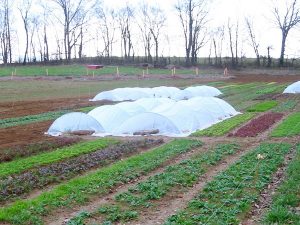Courtesy of Kevin G. Quarter Branch Farm, Lovettsville, VA
I started my 2 acre farm in the fall of 2009. I have grown most of the crops recommended in the SPIN guides. They have all been very popular at my farmers markets in the DC suburbs. The salads were not as profitable as I had hoped, due to the amount of labor it took to harvest, remove the decayed leaves, and bag. This year I am trying to eliminate the decayed leaves by sowing salad at a reduced density (rows 2.25″ apart, 2 seeds per inch in row) and harvesting at a younger stage (2″ leaf). But I’m not sure why I bother with the salad, since, for me, growing heads of romaine or leaf lettuce is far more profitable, both in terms of labor and area.
These are some of my favorite crops. I have found them to be easily marketable, efficient users of space, and economical to harvest (some might take practice). I sell all these items for $3/head or bunch. (Yes, the full-size lettuce is the same price as the mini-head). I used to do the 2/$5 discount. The math was easy and the transactions were often in easy dollar amounts, but I eventually phased out the discount since most people always buy at least two things anyways. I got tired of offering a 16.6% discount for no reason. Most people didn’t seem to mind.
- Full-Size Lettuce: I like Jericho plus some leaf types, 10″ x 10″ spacing. $3/each
- Mini-Head Lettuce: Try Claremont and some oakleaf types too, 6″ x 6″ spacing. I typically sold 100 mini heads per Saturday. $3/ea or 2/$5
- Carrots: Nelson in spring and Napoli in fall, rows 2.25″ apart, 2″ in row, bunch of 8-12 depending on size. $3/bunch, $4/bunch in winter Sweet turnips: Hakurei, rows 4″ apart, 2-3″ in row, bunch of 10), radishes, 2″ x 2″ spacing. Put out samples and they’ll be hooked. $3/bunch or pint
- Radishes: 2″ x 2″ spacing. $3/bunch
- Swiss chard: Bright Lights, transplant 10″ x 10″ apart. $3/bunch
- Butter chard: Fordhook Giant, direct seed rows 4″ apart, cut when leaves are smaller than 4″.Best-tasting salad green I’ve ever had. $3/ 1/4 lb
- Fennel: Orion. Last year I tried 10″ x 6″ but these heads were smaller and I only got $2/ea for them. This year I’m trying 18″ x 6″ and targeting $3/ea, which is the same income/square foot, but less labor/sf. Don’t disturb roots or cultivate too deeply or they’ll bolt. If they do, break off the seed stalk to focus energy on bulbing.
- Celery: Tango, 18″ x 8″. $3/each
- Shallots: These sell at my local grocery store for $1.20/ea (about the size of plum). Grow as many as you can.
- Cipollini onions: $3/bunch or pint
- Scallions: $2/bunch (bunches of 8
- Bunching leeks: $3/bunch
- Cucumbers: Diva, 42″ rows, 12″ in row, trellis. $3.50/lb
- Tomatoes: Big Beef, 42″ rows, 18″ in row, trellis. $3.50/lb
- Peppers: Ace, 18″ apart.$4/lb
I like to grow varieties that are eye-catching and have superior flavor. I found that it takes a lot of effort to sell uncommon vegetables such as kohlrabi or daikon. But if you know they are profitable, it could be worthwhile to be persistent in trying to develop a market for them. Signs, samples, and recipes really make a difference.
Try to find room to squeeze in some tomatoes, cucumbers, and peppers, if you can. These are not classic starter SPIN crops but I find they are extremely profitable to pick and, if you trellis them, they are very profitable per square foot also. Don’t let your personal preferences determine what you grow. I don’t like eating radishes but a lot of people do. I typically sell $120 to $200 of radishes at my Saturday market. Besides, I have found that I enjoy eating vegetables much more now that I grow them myself. There must be a relationship between the amount of work that goes into growing a vegetable and how good it tastes. Hopefully you will have a similar experience.

USE THE SAME PROGRAM THAT HELPED KEVIN GET STARTED HERE.. IF YOU’RE NOT READY TO GO ALL-IN JUST YET, MEET SUCCESSFUL FARMERS LIKE KEVIN IN OUR MEMBERSHIP GROUP HERE.


